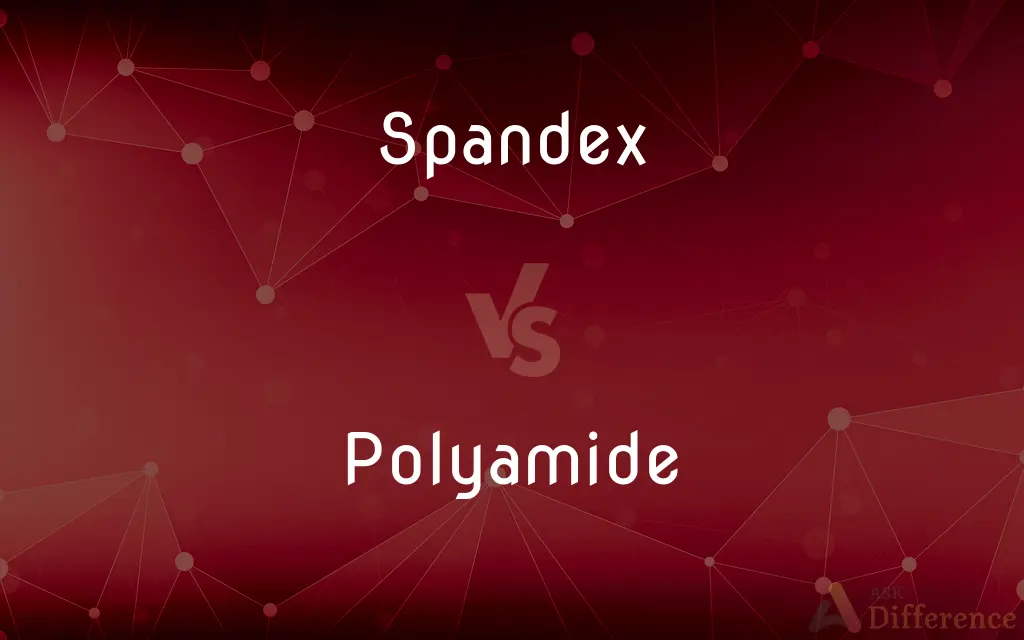Spandex vs. Polyamide — What's the Difference?
By Fiza Rafique & Maham Liaqat — Updated on April 4, 2024
Spandex is known for its exceptional elasticity and is used to add stretch to fabrics, while polyamide, a type of nylon, is prized for its durability and resistance to wear, often used in both apparel and technical textiles.

Difference Between Spandex and Polyamide
Table of Contents
ADVERTISEMENT
Key Differences
Spandex, also known as elastane or Lycra, is a synthetic fiber celebrated for its significant stretch and recovery capabilities. It is often blended with other fibers to enhance the elasticity and fit of garments, making it a staple in sportswear, swimwear, and activewear. On the other hand, polyamide (nylon) stands out for its strength and resistance to abrasion and moisture, making it ideal for a wide range of uses from clothing to outdoor gear and automotive applications.
The production process of spandex involves the extrusion of a polyurethane elastomer, which gives it the ability to stretch up to five times its original length and return to its original state without loss of form. Polyamide is produced through a condensation polymerization process, resulting in strong, long fibers that contribute to its durability and high melting point.
In terms of comfort and wearability, spandex provides a close, comfortable fit that moves with the body, offering freedom of movement and a second-skin feel. Polyamide, while also comfortable, is particularly valued for its ability to wick moisture away from the body, making it suitable for active and performance wear where moisture management is crucial.
From an environmental perspective, both spandex and polyamide are synthetic fibers that pose challenges in terms of biodegradability and environmental impact. However, there are ongoing efforts in the textile industry to recycle and develop more sustainable versions of these materials, reducing their ecological footprint.
Despite their differences, spandex and polyamide are often used together in fabrics to combine the best properties of both materials: the exceptional elasticity of spandex with the strength and moisture-wicking capabilities of polyamide. This synergy is evident in high-performance athletic wear, where the material needs to endure rigorous use while providing comfort and support.
ADVERTISEMENT
Comparison Chart
Elasticity
Extremely elastic
Less elastic
Durability
Durable, but more prone to wear without blend
Highly durable and abrasion-resistant
Moisture Management
Does not wick moisture away
Excellent moisture wicking
Production Process
Extruded polyurethane elastomer
Condensation polymerization
Common Uses
Sportswear, activewear, lingerie
Clothing, outdoor gear, industrial applications
Environmental Impact
Challenges in biodegradability
Similar challenges, with recycling options available
Compare with Definitions
Spandex
A synthetic fiber known for its exceptional elasticity.
Spandex leggings offer flexibility and comfort for yoga.
Polyamide
A type of nylon known for its durability.
Polyamide ropes are used for their strength and wear resistance.
Spandex
Faces environmental challenges, prompting sustainability efforts.
Recycled spandex is emerging as an eco-friendly alternative.
Polyamide
Resistant to moisture and abrasion.
Polyamide jackets are favored for outdoor activities due to their durability.
Spandex
Used to enhance the stretch of fabrics.
A dress with spandex content adapts better to body movements.
Polyamide
Offers moisture-wicking properties in textiles.
Polyamide sportswear helps keep athletes dry and comfortable.
Spandex
Provides a second-skin feel in garments.
Spandex in sportswear ensures a snug, supportive fit.
Polyamide
Subject to environmental impact concerns, with recycling efforts underway.
Recycled polyamide is used in eco-conscious fashion.
Spandex
Often blended with other materials for improved fit.
Cotton-spandex jeans combine comfort with stretch.
Polyamide
Used in a wide range of applications.
Automotive parts made from polyamide withstand high temperatures and friction.
Spandex
Spandex, Lycra, or elastane is a synthetic fiber known for its exceptional elasticity. It is a polyether-polyurea copolymer that was invented in 1958 by chemist Joseph Shivers at DuPont's Benger Laboratory in Waynesboro, Virginia, US.The generic name "spandex", which is an anagram of the word "expands", is the preferred name in North America.
Polyamide
A polyamide is a polymer with repeating units linked by amide bonds.Polyamides occur both naturally and artificially. Examples of naturally occurring polyamides are proteins, such as wool and silk.
Spandex
A type of stretchy polyurethane fabric
Gold spandex leggings
Polyamide
A synthetic polymer of a type made by the linkage of an amino group of one molecule and a carboxylic acid group of another, including many synthetic fibres such as nylon.
Spandex
A synthetic fiber or fabric made from a polymer containing polyurethane, used in the manufacture of elastic clothing.
Polyamide
A polymer containing repeated amide groups, as in various kinds of nylon.
Spandex
Of or relating to spandex or its elastic qualities.
Polyamide
(chemistry) Any of a range of polymers containing amide (or peptide) repeat units; examples include proteins and nylon.
Spandex
A synthetic fibre known for its exceptional elasticity.
Polyamide
A polymer containing repeated amide groups
Spandex
Clothing made from such material.
Spandex
An elastic textile material, used for clothing
Spandex
An elastic synthetic fabric
Common Curiosities
What is spandex mainly used for?
Spandex is primarily used to add elasticity and stretch to garments, making them more comfortable and adaptable to movement.
How does polyamide benefit athletic wear?
Polyamide benefits athletic wear by providing durability, abrasion resistance, and moisture-wicking properties, enhancing comfort and performance.
Why are spandex and polyamide often used together in fabrics?
They are blended to combine the elasticity of spandex with the strength, durability, and moisture management of polyamide, offering superior performance and comfort.
Can spandex and polyamide be recycled?
Both materials pose challenges in recycling due to their synthetic nature, but there are ongoing efforts to recycle and create more sustainable versions of these fibers.
What are the environmental concerns associated with spandex and polyamide?
The main concerns include their petroleum-based origins, long biodegradation times, and the release of microplastics, prompting the development of recycling methods and sustainable alternatives.
How does the production process of spandex and polyamide differ?
Spandex is produced by extruding a polyurethane elastomer, while polyamide is made through condensation polymerization, reflecting their distinct chemical structures and properties.
How do the properties of spandex and polyamide differ?
Spandex is primarily valued for its elasticity, while polyamide is chosen for its strength, abrasion resistance, and moisture management.
Are there sustainable alternatives to spandex and polyamide?
Yes, the industry is exploring sustainable options, including recycled materials and bio-based alternatives, to reduce their environmental impact.
What role does moisture management play in the performance of these fibers?
Moisture management is crucial for comfort and performance, especially in athletic wear. Polyamide's moisture-wicking properties keep the wearer dry, while spandex's elasticity ensures a comfortable fit.
How can consumers contribute to the sustainability of spandex and polyamide products?
Consumers can opt for products made from recycled materials, support brands that prioritize sustainability, and properly care for and dispose of synthetic garments to minimize environmental impact.
Share Your Discovery

Previous Comparison
Idempotence vs. Idempotency
Next Comparison
Idealism vs. PerfectionismAuthor Spotlight
Written by
Fiza RafiqueFiza Rafique is a skilled content writer at AskDifference.com, where she meticulously refines and enhances written pieces. Drawing from her vast editorial expertise, Fiza ensures clarity, accuracy, and precision in every article. Passionate about language, she continually seeks to elevate the quality of content for readers worldwide.
Co-written by
Maham Liaqat












































